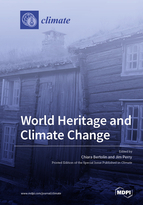World Heritage and Climate Change: Impacts and Adaptation
A special issue of Climate (ISSN 2225-1154).
Deadline for manuscript submissions: closed (31 March 2020) | Viewed by 48187
Special Issue Editors
Interests: biomimetic and bioinspired design; built environment; LCA; durability
Special Issues, Collections and Topics in MDPI journals
Interests: climate change adaptation; ecosystem management; world heritage; watershed management; decision making
Special Issues, Collections and Topics in MDPI journals
Special Issue Information
Dear Colleagues,
World Heritage represents natural and cultural resources so exceptional they should be conserved for all humankind forever. World Heritage sites and objects are the best of the best. Yet, many natural and cultural World Heritage sites are at risk from climate change. There is urgent need to understand the ways climate threatens various sites and artifacts, and to understand what adaptation strategies if any are appropriate for their conservation. The literature over the last 10 years is replete with discussions of risk assessments, planning strategies, and adaptation plans. We are awash with information but impeded by a dearth of understanding. This Special Issue brings together a select group of authors, each of whom brings together the available information on World Heritage in a changing climate. Each invited paper addresses a subset of the natural or built environment and synthesizes what is known and what uncertainties face decision makers.
Assoc. Prof. Chiara Bertolin
Prof. Dr. Jim Perry
Guest Editors
Manuscript Submission Information
Manuscripts should be submitted online at www.mdpi.com by registering and logging in to this website. Once you are registered, click here to go to the submission form. Manuscripts can be submitted until the deadline. All submissions that pass pre-check are peer-reviewed. Accepted papers will be published continuously in the journal (as soon as accepted) and will be listed together on the special issue website. Research articles, review articles as well as short communications are invited. For planned papers, a title and short abstract (about 100 words) can be sent to the Editorial Office for announcement on this website.
Submitted manuscripts should not have been published previously, nor be under consideration for publication elsewhere (except conference proceedings papers). All manuscripts are thoroughly refereed through a single-blind peer-review process. A guide for authors and other relevant information for submission of manuscripts is available on the Instructions for Authors page. Climate is an international peer-reviewed open access monthly journal published by MDPI.
Please visit the Instructions for Authors page before submitting a manuscript. The Article Processing Charge (APC) for publication in this open access journal is 1800 CHF (Swiss Francs). Submitted papers should be well formatted and use good English. Authors may use MDPI's English editing service prior to publication or during author revisions.
Keywords
- World Heritage
- natural and built environment
- decision making
- climate change
- climate change reconstruction and scenarios
- historical city center
- coastal erosion and sea level rise impacting coastal cities
- floods and landslides
- wind storm and heavy rainfall
- adaptation
- early warning systems at building, district, and urban scale
- impact assessment in post-disaster situations







